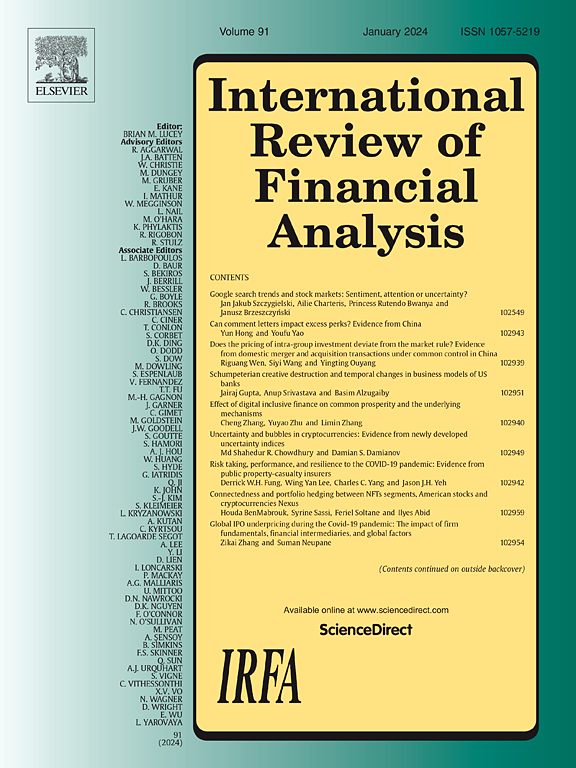What triggers intraday price jumps and co-jumps in gold?
IF 9.8
1区 经济学
Q1 BUSINESS, FINANCE
引用次数: 0
Abstract
What factors predict intraday price jumps and co-jumps in gold markets? Using high-frequency data, we find that intraday price jumps and co-jumps in gold are very rare yet extreme events with a probability of 0.43 %, while daily jumps occur with a probability of 32 %. Gold futures showcase a greater number of intraday jumps than gold ETFs. Positive jumps (0.22 %) are more frequent than negative jumps (0.20 %), while negative jumps (−1.78 %) have greater size than positive jumps (1.59 %). Using intraday event study and penalized regressions, we find the asymmetric yet heterogenous impact of news and social media-based market psych aspects (attention, sentiments, emotions). News attention predicts negative jumps, while social media attention predicts positive jumps. News emotions are the dominant predictor of jumps and co-jumps, especially during news. Negative news sentiments predict negative jumps, while positive social media sentiments predict positive jumps. US macroeconomic news predicts 34 % intraday price jumps in gold markets, with the FOMC rate decision being the dominant news surprise. Liquidity aspects like trading activity, transaction cost, and order imbalance showcase high predictability for jumps and co-jumps. Exchange rate volatility and stock market uncertainty prove to significantly cause price jumps and co-jumps in gold. Jump spillover analysis confirms that news attention is the largest net transmitter of jump spillovers while news sentiments and social emotions are the largest net receiver of jumps.
是什么触发了金价的盘中跳涨和同步跳涨?
什么因素预测了黄金市场的盘中价格上涨和同步上涨?使用高频数据,我们发现黄金的日内价格跳跃和共同跳跃是非常罕见的极端事件,概率为0.43%,而每日跳跃发生的概率为32%。与黄金etf相比,黄金期货的日内涨幅更大。正跳跃(0.22%)比负跳跃(0.20%)更频繁,而负跳跃(- 1.78%)比正跳跃(1.59%)更大。通过日内事件研究和惩罚回归,我们发现基于新闻和社交媒体的市场心理方面(注意力、情绪、情绪)的不对称但异质性的影响。新闻关注预示着消极的跳跃,而社交媒体关注预示着积极的跳跃。新闻情绪是跳跃和共同跳跃的主要预测因素,特别是在新闻期间。负面的新闻情绪预示着负面的跳跃,而积极的社交媒体情绪预示着积极的跳跃。美国宏观经济新闻预测黄金市场盘中价格将跃升34%,联邦公开市场委员会的利率决定是主要的新闻惊喜。流动性方面,如交易活动、交易成本和订单不平衡,显示出跳跃和共同跳跃的高可预测性。事实证明,汇率波动和股票市场的不确定性会显著导致黄金价格的上涨和同步上涨。跳跃溢出分析证实,新闻关注是跳跃溢出的最大净发送者,而新闻情绪和社会情绪是跳跃的最大净接收者。
本文章由计算机程序翻译,如有差异,请以英文原文为准。
求助全文
约1分钟内获得全文
求助全文
来源期刊

International Review of Financial Analysis
BUSINESS, FINANCE-
CiteScore
10.30
自引率
9.80%
发文量
366
期刊介绍:
The International Review of Financial Analysis (IRFA) is an impartial refereed journal designed to serve as a platform for high-quality financial research. It welcomes a diverse range of financial research topics and maintains an unbiased selection process. While not limited to U.S.-centric subjects, IRFA, as its title suggests, is open to valuable research contributions from around the world.
 求助内容:
求助内容: 应助结果提醒方式:
应助结果提醒方式:


